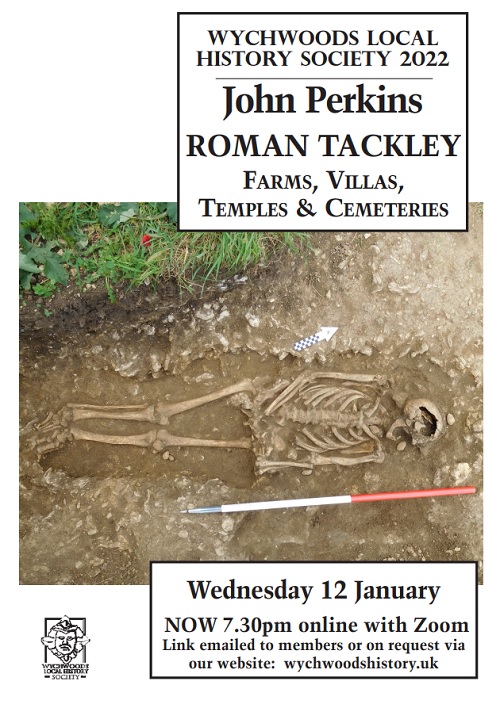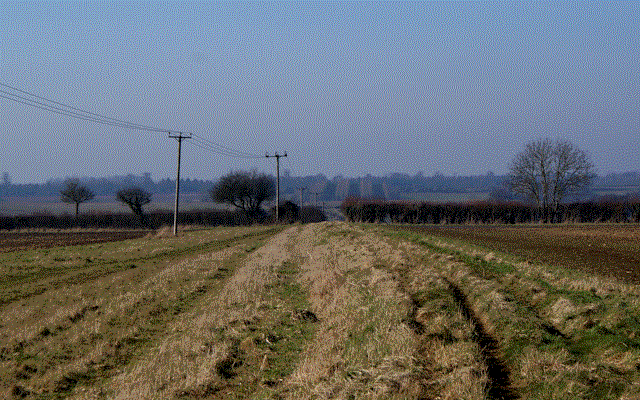
On Wednesday January 12th at 7.30 we were pleased to welcome John Perkins, who presented insights into Roman Tackley. John is a historian of science with a particular interest the science of 18th-century and Revolutionary France. Since retiring from Oxford Brookes he is now chair of the Tackley Local History Group and indulges a passion for local archaeology and history.
The talk – this time by Zoom due to the current uncertainties – was attended by 35+ members and guests.
John presented a fascinating talk on Roman Tackley, with many insights derived from fieldwalking, metal detecting and crop mark surveys, undertaken by members of the Tackley History Group and building on the research of others
Thanks to John’s planning, attendees were able to come prepared with a simple printout depicting the area around Tackley, highlighting the extraordinary number of farms and small settlements in the area. A PDF copy is here. What follows in this review can only include a few of the highlights among the many indicated on this map.
Roman Tackley: Farms, Villas, Temples and Cemeteries
John’s talk contextualised his subject in three main ways. Firstly, a simple historical timeline from the Iron Age (800BC – 43AD). From approximately 400BC the general increase in settled agricultural activity is reflected in the locality.
The area was at a junction of influence of three Iron Age tribes – the Dubonni, Catuvellauni and the Atrebates. The presence of Grim’s Ditch (including West of Tackley by the River Glyme) and Aves Ditch (a few miles to the North East of Tackley) are testament to existing settlements at the time of the arrival of the Romans in the early 1st century AD.

Secondly the growth of activity can be understood in the context of the building – and development from Iron Age causeways in parts – of Akeman Street by the Romans. This road joined the important administrative centres of Verulamium (St Albans) and Corinium Dobunnorum (Cirencester). Akeman Street joins modern Oxfordshire near Alcester. The road traversed the district which now includes the village of Tackley and so added to the region’s prosperity in the shape, for example, of the settlement at Sansom’s Platt. Sansom’s Platt straddles the border with Weaveley in Tackley parish and is a 1st-century farming settlement, succeeded by a villa occupied from the 2nd to the 4th century. This settlement grew to service the burgeoning activity around this important thoroughfare.
This example was one of several other settlements of growing importance, including Tackley itself and Gibraltar Point, a site which John’s Tackley History group has had the opportunity to excavate and research.
(More here )
And indeed this was the third thread of context for exploring the richness of the area: the development of archaeological interest in the region. This grew in no small measure from the enthusiasm of William Evetts (1847–1936), who was an owner of Tackley Park and Wood Farm and was a passionate amateur archaeologist who built up a large collection of artefacts found on the fields around the village.
More about William Evetts is here .
Evetts’ influence on the continuing desire to understand as much of the story is well-demonstrated by John’s fascinating research notes here

John was able to present in some detail, the work done by the Tackley Group: from examining crop marks, establishing archaeological digs with test trenches in promising locations, metal detecting and fieldwalking. These were all in the mix to present details of interesting finds including some high-value jewellery items, coins and pottery shards.
Star examples included a piece from an amphora originating in Spain and a bronze terret ring (dated approx. 150AD) found at Leys farm. This latter was part of a harness which did not show marks of wear. Excitingly, this could indicate it may have been a souvenir belonging to the farm’s owner: possibly then an ex-military man given the piece of land as a service reward in retirement?
We also learned a little of the methodology to understand and so calculate the possible population numbers of the area around Tackley. This was done by studying the density of pottery shards, coins and manure scatters, and so extrapolating the sizes of each individual farmstead. By comparing these with the 1851 census, when farming was still to see the machine-age in earnest, family sizes could be similar, and farm sizes clearly known. Thus, a population size could be arrived at using these parameters.
John’s talk did include a mention of the extraordinary find of the Street Farm villa in Tackley village. This was uncovered by a housing development and excavated in a short period ending in 2018, when the site was finally covered by the new buildings. The subject of this villa alone could easily occupy another evening’s presentation. More details are here
The evening gave us a wealth of information and insight. In particular we developed an understanding of an almost seamless development of farming and cultural activity which straddled the Iron Age and the Roman occupation to create what we might call Romano-British Tackley.

